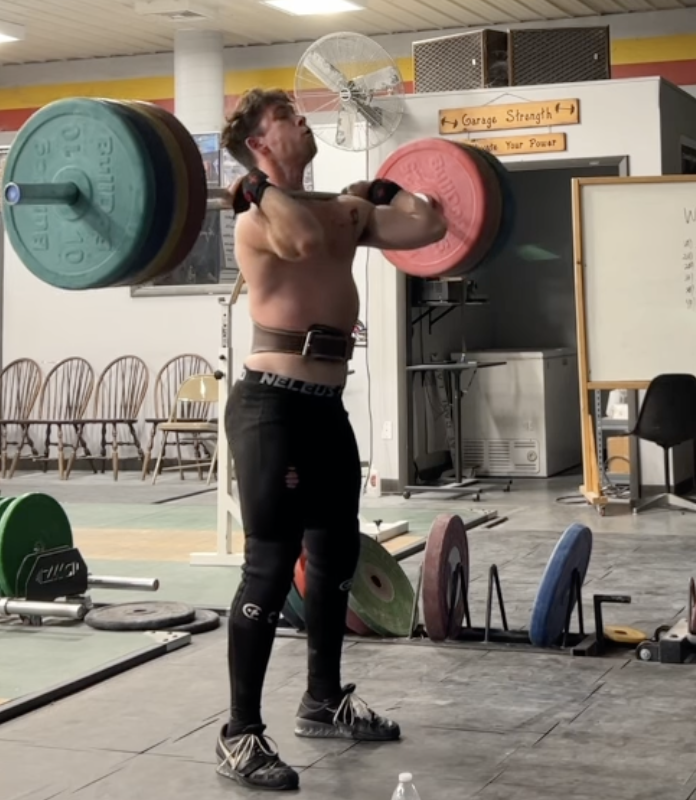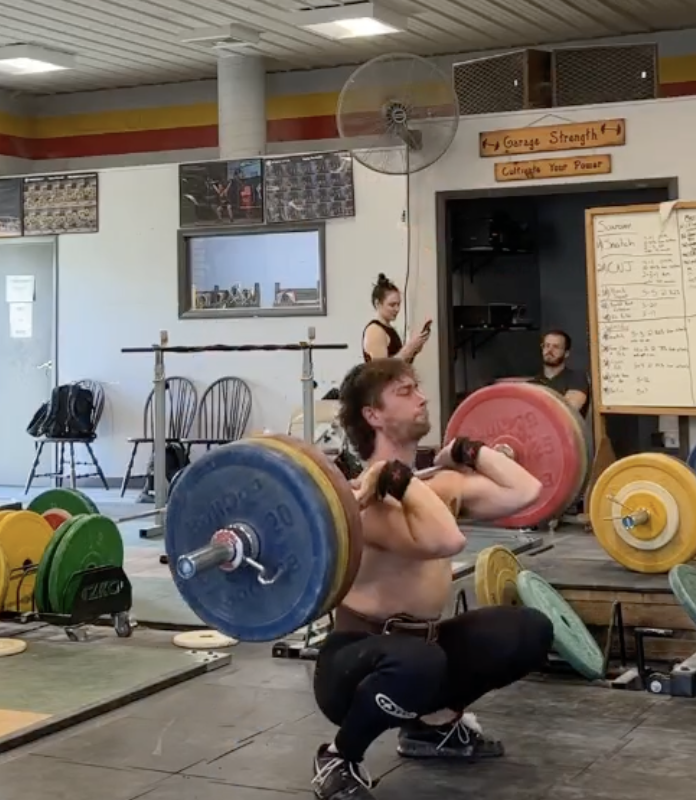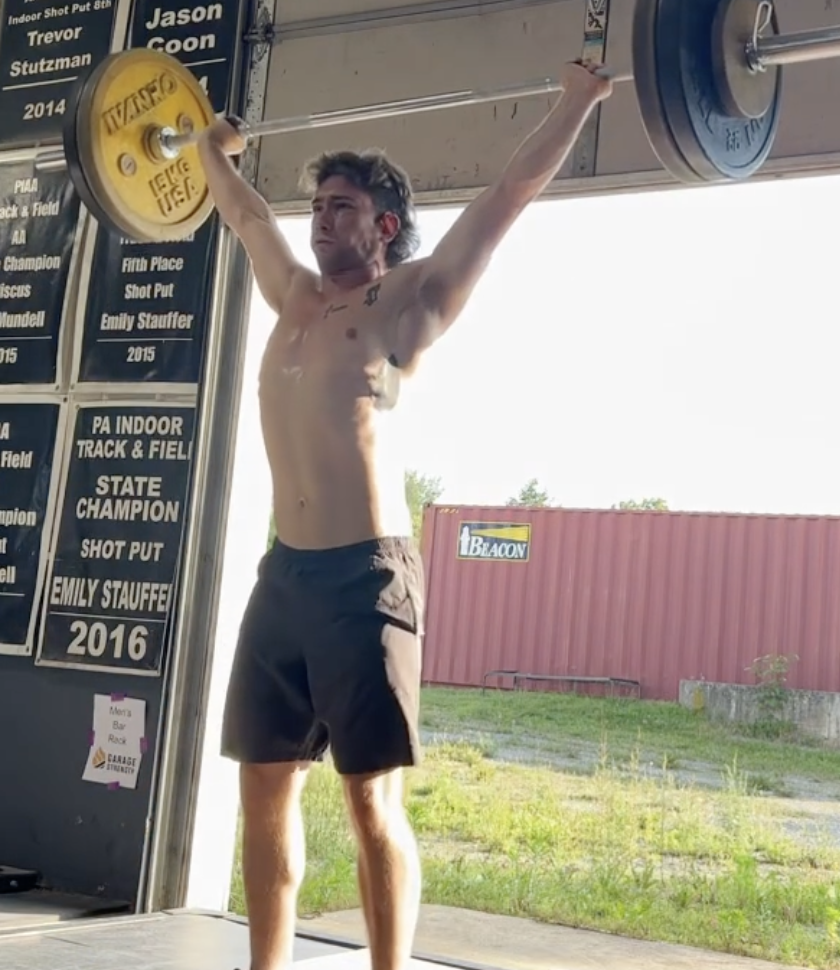Olympic Weightlifting and Muscle Building
Written by the Boostcamp staff
Does Olympic Weightlifting Build Muscle?
Are you looking for a workout routine that not only builds muscle mass but also challenges your body and mind? Look no further than Olympic weightlifting! Let's explore the relationship between Olympic weightlifting and muscle building. Many people think that Olympic Weightlifting is only good for athleticism and explosiveness, but it can be pretty beneficial for hypertrophy. Our team at Boostcamp will delve into the science behind it, compare it to other fitness routines, and provide practical tips on how to structure your Olympic weightlifting workout for optimal muscle growth.
Additionally, we will discuss the nutritional requirements for muscle growth and answer the question on everyone's mind: Can you gain muscle fast with Olympic weightlifting? So if you are ready to take your fitness journey to the next level, keep reading to find out why Olympic weightlifting is the perfect choice for building a muscular physique.
Let's dive in.
Understanding Olympic Weightlifting
To differentiate between powerlifting and weightlifting, powerlifting focuses on the big 3 compound lifts which are the squat, barbell bench press, and the deadlift. On the other hand, Olympic weightlifting, an ancient Greek sport that has been a part of the modern Olympic Games since 1896, is all about explosive movements and full-body strength. The main goal of this sport is to lift the heaviest weights possible in two specific lifts – the snatch and the clean and jerk. To excel in Olympic weightlifting, athletes need a combination of strength, power, speed, and technique. Training for this sport involves specific exercises and techniques aimed at enhancing performance in the snatch and clean and jerk. Lifters focus on barbell exercises that target various muscle groups, including the upper body, glutes, and leg muscles. By lifting heavier weights and performing compound exercises, Olympic weightlifting builds muscle strength, which not only improves performance in the sport but also helps with daily tasks that require physical strength.
The Origin and History of Olympic Weightlifting
Olympic weightlifting boasts an impressive history that dates back to the first Olympic Games in ancient Greece. Over time, the sport has undergone changes in rules and regulations to prioritize safety and fairness. It made its debut in the modern Olympic Games in 1896 and has been an integral part ever since. Throughout history, Olympic weightlifting has produced legendary athletes who have pushed the boundaries of human strength and performance. From the ancient Greeks to the present day, lifters have amazed audiences with their prowess and skill. The sport continues to evolve, with new training methods and techniques being developed to maximize performance. Olympic weightlifting's rich past and ongoing growth make it an exciting and respected Olympic sport.
The Principles of Olympic Weightlifting
The principles of Olympic weightlifting are centered around strength, power, speed, and technique. Proper technique and form play a crucial role in ensuring success and preventing injuries when participating in Olympic weightlifting. Another fundamental principle is progressive overload, where the weight lifted gradually increases over time. This allows lifters to continuously challenge themselves and build muscle strength. Olympic weightlifting also requires a high level of mobility, flexibility, and balance. Consistent training and dedication are key to mastering the techniques and improving performance in this demanding Olympic sport. By adhering to these principles and incorporating compound exercises that engage multiple muscle groups, lifters can achieve significant muscle growth and enhance overall physical fitness.
The Relationship Between Olympic Weightlifting and Muscle Building

Olympic weightlifting is known for its ability to build muscle, but it's important to note that it's not the only method available. Muscle building occurs as a result of the progressive overload principle in Olympic weightlifting. This means gradually increasing the amount of weight lifted over time to continue challenging the muscles. The explosive movements involved in Olympic weightlifting target multiple muscle groups simultaneously, leading to overall muscle development. Lifters engage their biceps, their glutes, and really the leg muscles as a whole, among others, during these compound exercises. The heavy weights used in Olympic weightlifting stimulate muscle growth and hypertrophy, making it an effective way to build muscle. For optimal results, Olympic weightlifting can be combined with other types of strength training exercises. By incorporating a variety of exercises, lifters can target different muscle groups and achieve a well-rounded physique.
How Olympic Weightlifting Affects Muscle Growth
Olympic weightlifting has a profound impact on muscle growth. This is because it stimulates the recruitment of fast-twitch muscle fibers, which are responsible for explosive movements. These explosive movements, characteristic of Olympic weightlifting exercises, promote muscle hypertrophy and increase power output. The heavy loads used in Olympic weightlifting result in muscle damage, which then leads to repair and subsequent muscle growth. It's important to note that proper nutrition plays a crucial role in optimizing muscle growth during Olympic weightlifting, with adequate protein intake being particularly important. Incorporating compound exercises like the overhead press and using heavier weights not only targets specific muscle groups but also helps improve overall muscle strength. Olympic weightlifting is a comprehensive form of strength training that significantly contributes to muscle development.
The Science Behind Muscle Building in Olympic Weightlifting
Olympic weightlifting, as an intense and explosive form of strength training, activates muscle protein synthesis, stimulating muscle growth and repair. The eccentric (lengthening) and concentric (shortening) phases of Olympic weightlifting exercises trigger different mechanisms of muscle hypertrophy. Furthermore, hormones like testosterone and growth hormone play a significant role in the muscle-building process during Olympic weightlifting. The high force and tension generated by lifting heavy weights promote muscle fiber recruitment and stimulation, leading to increased muscle strength and size. However, it's important to note that progressive overload and proper recovery are crucial factors in maximizing muscle growth through Olympic weightlifting. By progressively increasing the amount of weight lifted and allowing sufficient rest between training sessions, lifters can optimize their muscle-building potential. So, if you're looking to build muscle, incorporating Olympic weightlifting into your workout routine can be an effective strategy.
Is Olympic Weightlifting the Best Way to Build Muscle?
While Olympic weightlifting can be effective for muscle building, it may not be the optimal choice for everyone. The focus is on improving performance in snatch and clean and jerk, rather than solely building muscle. Factors like technique, form mastery, and individual preferences should be considered when determining the best way to build muscle.
Comparing Olympic Weightlifting with Other Fitness Routines
When it comes to comparing Olympic weightlifting with other fitness routines, there are several key differences to consider. Olympic weightlifting focuses on explosive power and full-body strength, making it a great choice for those looking to develop overall athleticism. In contrast, bodybuilding routines prioritize muscle hypertrophy and aesthetics, with a focus on sculpting specific muscle groups. Powerlifting routines, on the other hand, emphasize maximal strength in the squat, bench press, and deadlift. Endurance-based routines may not prioritize muscle building as much as Olympic weightlifting, as their main goal is improving cardiovascular endurance. It's important to note that different fitness routines offer unique benefits, and they can be combined or modified to suit individual goals and preferences. By understanding these differences, individuals can make informed decisions about the type of exercise that aligns with their fitness goals and aspirations.
The Benefits and Drawbacks of Olympic Weightlifting for Muscle Growth
Olympic weightlifting offers numerous benefits for muscle growth. This type of strength training promotes overall strength, power, and explosiveness, which can enhance muscle development. By targeting multiple muscle groups simultaneously, Olympic weightlifting helps achieve balanced muscle growth. Additionally, engaging in this challenging exercise can improve bone density and joint stability, thereby indirectly supporting muscle growth. However, there are also drawbacks to consider. Olympic weightlifting requires proper technique and may have a steeper learning curve compared to other resistance training methods. Furthermore, it may not provide enough volume or specific isolation exercises for certain muscle groups. Individuals with certain injuries or physical limitations may find Olympic weightlifting unsuitable. Nonetheless, when done correctly and with guidance, Olympic weightlifting can be a valuable addition to a muscle-building regimen.
How to Build Muscle through Olympic Weightlifting

To maximize muscle building through Olympic weightlifting, it's essential to lay a solid foundation of strength and conditioning. To do this, seek guidance from a qualified coach or trainer who can teach you the proper techniques and form. Remember to gradually increase the weight you lift to ensure progressive overload, which stimulates muscle growth. In addition to Olympic weightlifting exercises, incorporate accessory exercises that target specific muscle groups, such as biceps curls or kettlebell swings. Don't forget to prioritize recovery by getting adequate rest, focusing on proper nutrition, and getting enough sleep. These practices will optimize muscle building and help you reap the benefits of Olympic weightlifting.
Choosing the Right Exercises in Olympic Weightlifting for Muscle Growth
When it comes to muscle growth in Olympic weightlifting, choosing the right exercises is crucial. To maximize muscle development, it's important to select exercises that target multiple muscle groups. Compound lifts like the clean and jerk and snatch are excellent choices as they activate muscles throughout the entire body. Additionally, focusing on exercises that allow for a wide range of motion can engage more muscle fibers, leading to greater muscle activation and growth. Incorporating accessory exercises is also beneficial, as they help strengthen specific muscle groups and prevent imbalances. Varying your training routine regularly is essential to continuously challenge and stimulate muscle growth. By incorporating these principles into your Olympic weightlifting workouts, you can optimize muscle growth and achieve your fitness goals.
Structuring Your Olympic Weightlifting Workout for Optimal Muscle Growth
To structure your Olympic weightlifting workout for optimal muscle growth, it is important to prioritize heavy, compound lifts at the beginning of your session. This will maximize muscle recruitment and set a solid foundation for your workout. Incorporate progressive overload by gradually increasing the weight or reps over time. This allows your muscles to adapt and grow stronger. Remember to allow adequate rest between sets to ensure proper muscle recovery and growth. Including variations of Olympic lifts in your routine can target different muscle fibers and promote muscle hypertrophy. Additionally, incorporating accessory exercises can strengthen weak areas and enhance overall muscle development. By following these guidelines, you can create an effective Olympic weightlifting workout that will help you build muscle and achieve your fitness goals.
Nutrition for Olympic Weightlifters Seeking Muscle Growth
To optimize muscle growth and support intense workouts, Olympic weightlifters should focus on consuming a balanced diet that includes an adequate amount of protein, carbs, and fats. Aim for a calorie surplus to provide the energy needed for training sessions and muscle recovery. Prioritize high-quality protein sources like lean meats, eggs, and legumes to support muscle repair and growth. Carbohydrates are essential for fueling workouts and replenishing glycogen stores, so include foods like whole grains, fruits, and vegetables. Don't forget about healthy fats, which play a crucial role in hormone production and optimizing muscle-building processes. Incorporate sources like nuts, avocados, and olive oil into your diet. By addressing your nutritional needs and maintaining a well-rounded approach, you can enhance muscle growth while engaging in Olympic weightlifting.
Understanding the Nutritional Requirements for Muscle Growth
To support muscle growth and repair, it is important to consume a sufficient amount of calories. Additionally, ensuring an adequate intake of protein is crucial as it provides the building blocks for muscle synthesis. Including complex carbohydrates in your diet is essential to fuel intense workouts and promote muscle glycogen storage. Healthy fats should also be incorporated as they are important for hormone production, joint health, and overall well-being. Staying properly hydrated is another important factor as it supports muscle function and nutrient absorption. By following these nutritional requirements, you can optimize your muscle growth potential and enhance your performance in Olympic weightlifting. Remember to prioritize your caloric intake and include a balance of protein, carbs, and fats to fuel your training sessions and support muscle development.
The Role of Protein, Carbs, and Fats in Muscle Building for Olympic Weightlifters
When it comes to muscle building for Olympic weightlifters, the role of protein, carbs, and fats is crucial. Protein is essential for muscle repair and growth, so aim for a daily intake of grams per pound of body weight. Carbohydrates provide the energy needed for intense workouts and support muscle glycogen storage, so focus on consuming complex carbs. Healthy fats play a key role in hormone production and overall health, so prioritize sources like nuts, avocados, and olive oil. By incorporating these macronutrients into their diet, Olympic weightlifters can optimize their muscle-building efforts and support their overall performance. Remember, fueling your body with the right nutrients is just as important as the lifting itself.
Can You Gain Muscle Fast with Olympic Weightlifting?

Olympic weightlifting, when combined with proper nutrition and training, can lead to rapid muscle growth. Consistency and progressive overload are key for maximizing gains. It's important to have realistic expectations and focus on long-term progress. Consult with a qualified coach to design a tailored program for your goals.
The realistic timeline for muscle growth with Olympic weightlifting
Building muscle through Olympic weightlifting is a gradual process that requires time, consistency, and dedication. Results can vary depending on individual factors such as genetics, training intensity, and nutrition. With proper training and a well-balanced diet, noticeable muscle growth can typically be observed within a few months of consistent effort. However, it's important to note that significant muscle gains may take a year or more of dedicated training and adherence to a structured program. Patience and persistence are key when it comes to achieving long-term muscle growth with Olympic weightlifting. By consistently challenging yourself with heavier weights, focusing on compound exercises that engage multiple muscle groups, and providing your body with the necessary nutrients for recovery and growth, you can gradually increase your muscle strength and see the results you desire.
How Does Olympic Weightlifting Impact Body Composition?
Olympic weightlifting has a significant impact on body composition. It promotes muscle hypertrophy and strength gains through explosive movements. Additionally, the high-intensity nature of weightlifting leads to increased calorie burn and fat loss. It also improves bone density and overall athleticism.
Why Do Olympic Weightlifters Have a Muscular Physique?
Olympic weightlifters have impressive muscle development due to their training regimen. The heavy loads and explosive movements stimulate muscle growth, while compound lifts target multiple muscle groups. Consistent training, proper nutrition, and sufficient recovery also contribute to their muscular physique.
Looking for a Workout Program?
If you are looking for a workout program to follow, check out the Boostcamp App! There are over 50 FREE workout programs from some of the best coaches out there. You can follow a program, or even create your own using Boostcamp's Program Creator. A workout program allows you to track progress and hold yourself accountable as well.
Conclusion
In conclusion, Olympic weightlifting is a highly effective way to build muscle. It has a long-standing history and proven principles that contribute to significant muscle growth. The science behind muscle building in Olympic weightlifting is well-established, making it a reliable choice for those looking to increase muscle mass. While there are other fitness routines available, Olympic weightlifting offers unique benefits and drawbacks specific to muscle growth. To maximize your muscle gains, it is essential to choose the right exercises and structure your workouts accordingly. Additionally, proper nutrition plays a crucial role in supporting muscle growth. By following a well-rounded approach and staying dedicated, you can achieve impressive muscle development through Olympic weightlifting. So, why wait? Start incorporating Olympic weightlifting into your fitness routine and enjoy the benefits of a muscular physique.
Be sure to follow Boostcamp on Instagram and subscribe on YouTube!

Images courtesy of Ivan Escott (@depth.vader)

